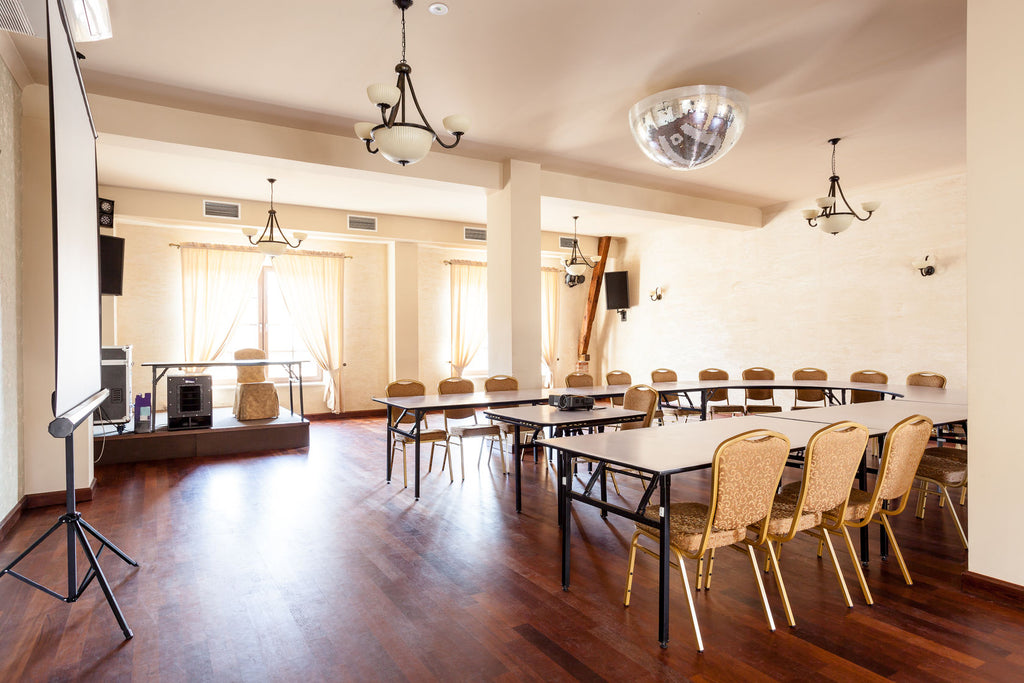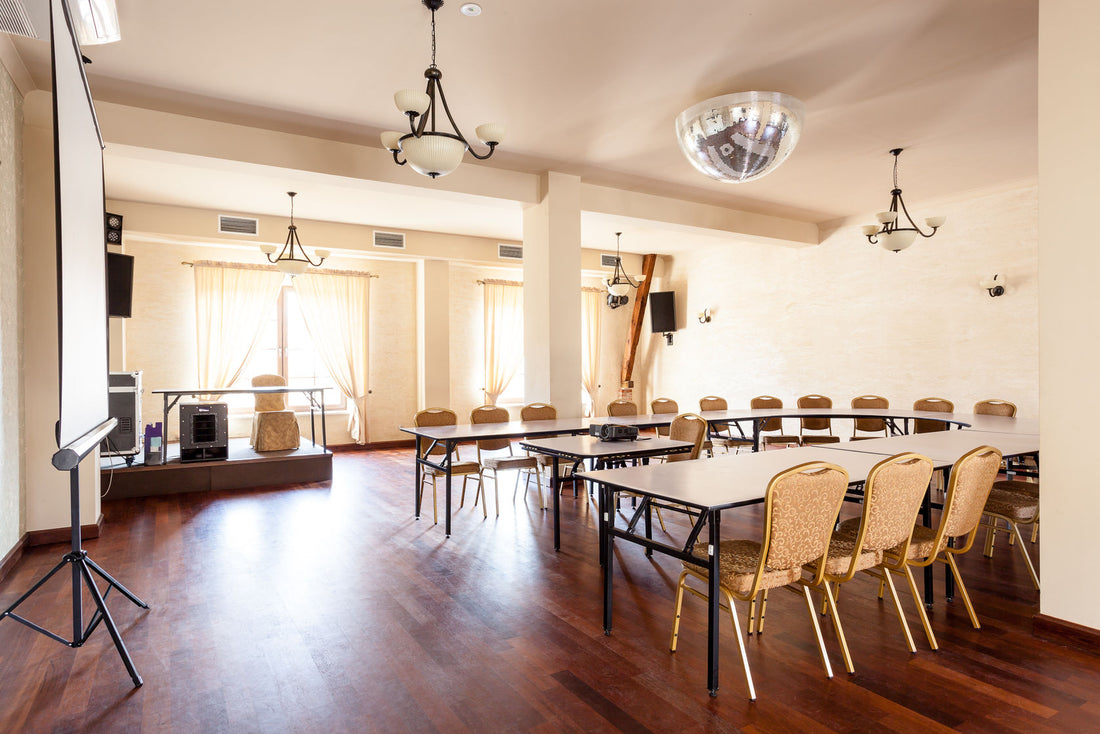When it comes to flooring options in commercial spaces, hardwood may not always be the first choice that comes to mind. However, hardwood flooring is gaining popularity for its timeless appeal, durability, and ability to create a warm and inviting atmosphere in commercial settings. In this blog, we will explore the various aspects of using hardwood flooring in commercial spaces, from its benefits to considerations and design ideas. Whether you own a restaurant, retail store, office, or any other commercial establishment, read on to discover why hardwood flooring could be the perfect choice to enhance your workspace.
The Appeal of Hardwood in Commercial Spaces

Hardwood flooring has a unique charm that can transform the ambiance of commercial spaces. Here's why it's becoming a go-to option for business owners:
Timeless Elegance
Hardwood flooring exudes a sense of timeless elegance that never goes out of style. It can make your commercial space feel more inviting and upscale, creating a positive impression on customers, clients, and employees.
Durability for Heavy Traffic
Commercial spaces experience high foot traffic, and durability is crucial. Hardwood is known for its ability to withstand wear and tear, making it an excellent choice for areas that see a lot of action.
Low Maintenance
Hardwood floors are relatively easy to clean and maintain, making them a practical choice for busy commercial environments. Regular sweeping and occasional polishing can keep them looking pristine.
Versatile Design Options
Hardwood comes in a variety of wood species, colours, and finishes, allowing you to tailor the flooring to match your brand's aesthetic. Whether you prefer a classic oak or a sleek, modern look, hardwood offers versatility.
Considerations for Choosing Hardwood in Commercial Spaces

While hardwood offers numerous advantages, there are some key considerations to keep in mind:
- Traffic and Wear: Assess the level of foot traffic your space experiences. Heavier traffic areas may benefit from harder wood species like oak or maple, which are more resistant to dents and scratches.
- Finish and Maintenance: Choose a finish that suits your maintenance schedule and needs. Some finishes are more resilient against stains and wear, ideal for high-traffic areas.
- Budget: Hardwood can be a significant investment, but it also adds long-term value to your space. Consider your budget and explore options that balance cost and quality.
Design Ideas for Commercial Hardwood Flooring

Now, let's explore some design ideas to inspire your commercial space:
- Classic Elegance: Choose rich, dark hardwoods like mahogany or cherry for an upscale, traditional look. This works well for high-end restaurants, law offices, and luxury boutiques.
- Modern Minimalism: Opt for lighter woods, such as maple or ash, and a matte finish for a clean and contemporary appearance. This suits tech startups, modern offices, and trendy retail spaces.
- Rustic Charm: Embrace the beauty of distressed hardwood for a cozy and welcoming atmosphere. This can be perfect for cafes, artisan shops, and countryside inns.
- Brand Colours: Consider staining the hardwood to match your brand colours for a cohesive and branded look.
What Maintenance Practices Are Recommended To Keep Hardwood Flooring In Commercial Spaces Looking Its Best?
Maintaining hardwood flooring in commercial spaces is essential to preserve its beauty, durability, and longevity. Here are recommended maintenance practices to keep hardwood flooring looking its best:
- Daily Cleaning:
Sweep or Dust Mop: Regularly sweep or dust mop the floors to remove dust, dirt, and debris that can scratch the surface.
Damp Mop: Use a damp mop with a pH-neutral hardwood floor cleaner to remove more stubborn dirt. Avoid excessive water, as standing moisture can damage wood.
- Preventive Measures:
Walk-off Mats: Place walk-off mats at entrances to trap dirt and moisture before they reach the hardwood. Ensure these mats are kept clean and replaced when worn.
Felt Pads: Attach felt pads to the legs of furniture to prevent scratches and scuffs when moving or rearranging.
Area Rugs: In high-traffic areas, use area rugs with non-slip pads to protect the flooring and reduce wear.
- Spill Cleanup:
Prompt Cleanup: Immediately wipe up spills to prevent moisture from seeping into the wood, which can lead to warping or staining.
Avoid Harsh Cleaners: Use a hardwood floor cleaner recommended by the manufacturer to clean spills or stains. Avoid abrasive or acidic cleaners that can damage the finish.
- Regular Inspection:
Check for Wear: Regularly inspect the hardwood for signs of wear, such as scratches, dents, or worn areas. Address any issues promptly to prevent further damage.
- Professional Maintenance:
Refinishing: Depending on the level of wear, hardwood floors in commercial spaces may need refinishing every few years. This process involves sanding down the old finish and applying a new one, restoring the floor's luster.
Deep Cleaning: Periodically, consider professional deep cleaning to remove deeply embedded dirt and grime.
- Climate Control:
Maintain Consistent Humidity: Fluctuations in humidity can cause wood to expand and contract, leading to gaps or warping. Maintain a consistent indoor humidity level, typically between 35% and 55%.
Temperature Control: Avoid extreme temperature changes, as they can also impact the stability of the wood.
- Mats and Protectors:
Chair Mats: Use chair mats under office chairs with casters to prevent damage from rolling.
Entryway Protectors: Install transition strips and thresholds at doorways to protect the edges of the hardwood.
- Employee Training:
Educate Staff: Train employees on proper cleaning and maintenance procedures to ensure consistent care of the hardwood flooring.
- Timely Repairs:
Address Repairs: If you notice any damage or issues, such as loose boards or squeaks, address them promptly to prevent further damage.
- Rug Rotation:
Rotate Area Rugs: If you use area rugs, periodically rotate them to ensure even wear on the hardwood underneath.
By following these maintenance practices, you can extend the life of your hardwood flooring in commercial spaces, keeping it looking its best and preserving its appeal for years to come. Additionally, consult with the manufacturer's guidelines and consider professional advice for more specific care instructions tailored to your hardwood floor type.
What Are The Trends In Commercial Hardwood Flooring Design And Usage?

Commercial hardwood flooring design and usage have seen several trends emerge in recent years, reflecting a shift towards more versatile, sustainable, and aesthetically pleasing options.
Sustainable Hardwood
Sustainability is a dominant trend. Businesses are increasingly opting for hardwood flooring sourced from sustainably managed forests or reclaimed wood, aligning with eco-conscious values. This trend reflects the growing emphasis on environmental responsibility and the desire to use materials that have minimal ecological impact.
Wide Planks
Wide-plank hardwood flooring has gained popularity in commercial spaces. It offers a more contemporary and open look, creating a sense of spaciousness and elegance. This trend is particularly prevalent in modern office settings and high-end retail spaces.
Lighter Finishes
Lighter wood finishes, such as blond oak and pale maple, have become fashionable in commercial settings. These finishes create a fresh, airy, and modern ambiance. They are often chosen to enhance natural light and make spaces appear more inviting.
Matte Finishes
Matte finishes are replacing glossy ones in many commercial hardwood flooring applications. Matte finishes offer a more natural and subdued appearance, hiding minor scratches and imperfections better while providing a contemporary, understated look.
Pattern Mixing
Combining different wood species or introducing intricate patterns like herringbone or chevron has become a way to add uniqueness and character to commercial spaces. This design approach is popular in upscale restaurants, boutique hotels, and trendy boutiques.
Minimalist Aesthetic
Minimalist design is on the rise, especially in modern office spaces. Clean lines, simple patterns, and unadorned hardwood contribute to a sleek and clutter-free environment, promoting productivity and a sense of calm.
Hybrid Flooring
Some commercial spaces are opting for engineered hardwood flooring, which offers enhanced durability and resistance to moisture. Engineered hardwood can be a practical choice in areas where traditional hardwood may be less suitable due to fluctuating environmental conditions.
Biophilic Design
With a focus on bringing the outdoors inside, biophilic design principles are being incorporated into commercial spaces. Hardwood flooring, with its natural warmth and texture, plays a significant role in creating environments that connect occupants with nature.
Personalized Branding
Commercial spaces are increasingly using customized hardwood flooring to reflect their brand identity. This includes incorporating logos, patterns, or colours that align with the business's unique branding.
Vintage and Reclaimed Looks
To add a sense of history and authenticity, vintage and reclaimed hardwood flooring styles are making a comeback. These floors bring character and a sense of storytelling to spaces, often seen in eclectic cafes, bars, and boutique shops.
These trends in commercial hardwood flooring design and usage demonstrate a growing desire for flooring options that not only enhance the aesthetics of a space but also align with sustainability goals, functional needs, and the desire to create unique and inviting environments for employees and customers alike. Businesses are increasingly recognizing the role that hardwood flooring plays in setting the tone and atmosphere of their commercial spaces.
Conclusion: Elevating Your Commercial Space
Hardwood flooring in commercial spaces is more than just a design choice; it's an investment in your brand's image and the functionality of your space. Its durability, timeless appeal, and design versatility make it a compelling option for various businesses. Whether you want to create a classic, modern, or rustic ambiance, hardwood can help you achieve the desired look. Explore the possibilities and elevate your commercial space with the enduring beauty of hardwood flooring.
Flooring blog articles you may want to read:
Protecting Hardwood Flooring From Furniture: What Should You Do?
Shaw Floorte Waterproof Hardwood Flooring Introduced
The Experiential Benefits of Engineered Hardwood Flooring
